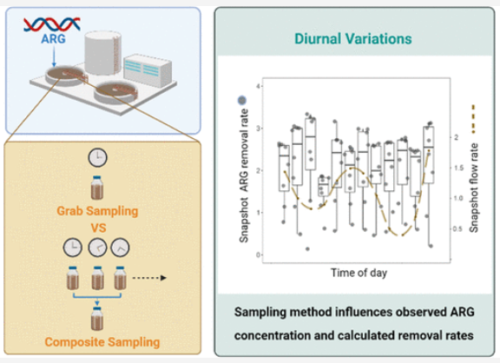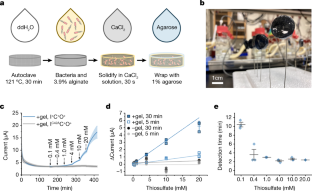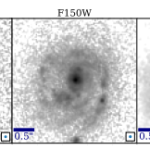抗生物質耐性遺伝子を見つけるライス大学の方法は、「スナップショット」サンプル、塩素消毒の限界を示す Rice method to find antibiotic-resistant genes shows limits of ‘snapshot’ samples, chlorination
2022-12-19 ライス大学
この新しい研究により、都市部の下水処理場で24時間かけて採取された複合サンプルは、水中の抗生物質耐性遺伝子(ARG)のレベルをより正確に表すことができることが明らかになりました。米国疾病管理予防センター(CDC)によると、抗生物質耐性は、世界中で数百万人の死亡につながる世界的な健康上の脅威となっています。
その過程で、研究者たちは、二次廃水処理によって対象となるARGの量は大幅に減少するものの、後段の処理でしばしば使用される塩素系消毒剤が、状況によっては、再び環境に放出される水に悪影響を与える可能性があることを発見しました。
ライス大学ジョージ・R・ブラウン・スクール・オブ・エンジニアリングのローレン・スタドラー教授の研究室では、複合サンプル中の抗生物質耐性RNA濃度が、下水処理場の流量が最小のときに採取したスナップショット「グラブ」よりも10倍高いことが報告されています。
Stadlerと、彼女の研究室の大学院生である主著者のEsther LouとPriyanka Aliは、この結果を米国化学会誌『Environmental Science & Technology:Water』に発表しました。
この結果は、工場で繁殖し、環境中の他の生物にその遺伝子を移す可能性のあるバクテリアの抗生物質耐性遺伝子の蔓延を抑えるための、廃水処理のより良いプロトコルにつながる可能性があります。
<関連情報>
- https://news.rice.edu/news/2022/daylong-wastewater-samples-yield-surprises
- https://pubs.acs.org/doi/10.1021/acsestwater.2c00467
- https://www.nature.com/articles/s41586-022-05356-y
スナップショット 下水処理場のARG除去率は、日内変動があるため代表的なものではありません。 Snapshot ARG Removal Rates across Wastewater Treatment Plants Are Not Representative Due to Diurnal Variations
Esther G. Lou, Priyanka Ali, Karen Lu, Prashant Kalvapalle, and Lauren B. Stadler
Environmental Science & Technology: Water Published:December 15, 2022
DOI:https://doi.org/10.1021/acsestwater.2c00467

Abstract
To evaluate the threat of the environmental dissemination of antibiotic resistance associated with wastewater treatment plants (WWTPs), the removal efficiency of antibiotic resistance genes (ARGs) during wastewater treatment needs to be assessed. The sample collection strategy is one factor that is often overlooked in study design and most studies on ARGs in wastewater perform grab sampling. Here, we hypothesized that wastewater sampling (i.e., grab and composite sampling) influences the observed ARG concentrations and calculated removal rates across WWTPs. We compared the removal rates calculated based on the two different sampling methods for several genes, including some clinically relevant ARGs (blaNDM-1, blaOXA-1, MCR-1, MCR-5, MCR-10, and qnrA). We conducted summer and winter 24 h sampling campaigns where grab samples were collected every 2 h from the influent, secondary effluent, and final effluent. The snapshot removal rate of each target gene calculated based on the 12 grab samples fluctuated by 0.5–1.6 log in the winter and 0.9–2.7 log in the summer, indicating diurnal variation. Overall, for each target gene, the removal rates calculated based on 24 h composite samples were approximately equal to the median of the 12 snapshot removal rates. Our study confirms the importance of using composite samples to monitor ARGs in wastewater.
環境汚染物質のリアルタイム・バイオエレクトロニクス・センシング Real-time bioelectronic sensing of environmental contaminants
Joshua T. Atkinson,Lin Su,Xu Zhang,George N. Bennett,Jonathan J. Silberg & Caroline M. Ajo-Franklin
Nature Published:02 November 2022
DOI:https://doi.org/10.1038/s41586-022-05356-y

Abstract
Real-time chemical sensing is crucial for applications in environmental and health monitoring1. Biosensors can detect a variety of molecules through genetic circuits that use these chemicals to trigger the synthesis of a coloured protein, thereby producing an optical signal2,3,4. However, the process of protein expression limits the speed of this sensing to approximately half an hour, and optical signals are often difficult to detect in situ5,6,7,8. Here we combine synthetic biology and materials engineering to develop biosensors that produce electrical readouts and have detection times of minutes. We programmed Escherichia coli to produce an electrical current in response to specific chemicals using a modular, eight-component, synthetic electron transport chain. As designed, this strain produced current following exposure to thiosulfate, an anion that causes microbial blooms, within 2 min. This amperometric sensor was then modified to detect an endocrine disruptor. The incorporation of a protein switch into the synthetic pathway and encapsulation of the bacteria with conductive nanomaterials enabled the detection of the endocrine disruptor in urban waterway samples within 3 min. Our results provide design rules to sense various chemicals with mass-transport-limited detection times and a new platform for miniature, low-power bioelectronic sensors that safeguard ecological and human health.



